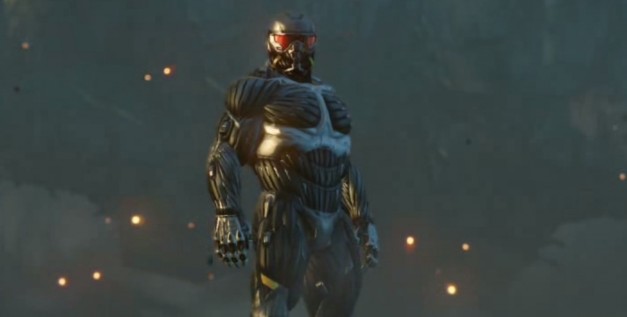Our Verdict
Visually near-perfect, but the ample action is bottlenecked by narrower level design and a weaker Nanosuit.
PC Gamer's got your back
An alien dropship hums overhead, trailing otherworldly ruby-red fumes from its engines. The patrol craft spits shining metal pods at the earth as it passes. Embedded in the city street asphalt, the pods pop like pressurized eggs; three raptor-legged, inquisitive Ceph soldiers spring out.
They can't see me, but I'm a mere 20 feet away, invisible, steel feet perched still atop a shipping crate. I'm holding the wrong gun for this—a microwave gun would've been ideal—but I don't care. I love the way my SCARAB assault rifle's laser sight attachment seems to wander organically, slightly out of sync with my movements, illuminating what I'm about to kill. I center it on the aliens' weak spot: an exposed patch of pink-goo translucence where tendrils dangle—like Cthulhu's tentacles—from their back.
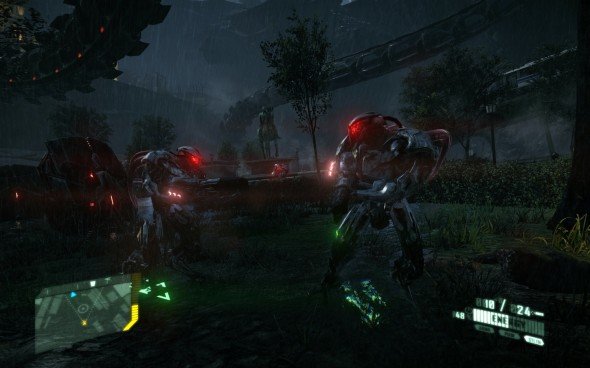
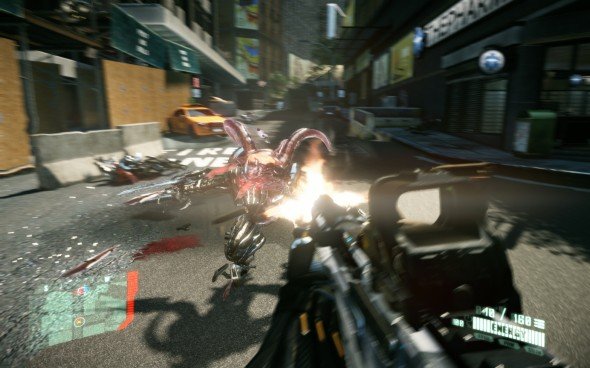
As the aliens' formation fans out, I seize the moment and fizzle out of stealth mode. Eight rounds ping the Ceph commander, but he doesn't die. In two seconds, he'll activate a shield that makes him four times harder to kill. I can't take him down in time—I need to flee. I sprint-leap off the container and tap Q; the voice in my head murmurs “MAXIMUM ARMOR,” and I hear my suit's skin go hyper-dense, just in time to absorb the fall damage. I backpedal into an alley—my armor can't sponge the damage from another energy blast. I need to find cover, but turning to look in the direction I'm walking would cost a precious second that I don't have.
I think my back is near a wall—I've got to trust that that's true. I spend my last Nanosuit energy on a hail Mary blind leap, holding the spacebar as I mentally cross my fingers. I hear a robotic whoosh—like a high-tech trampoline. Twenty feet off the ground, my feet find a cobblestone ledge. I cloak and dart off. I've never felt more like Batman in a game—and that includes Batman games.
New York minuteman
Crysis 2 is at its best when it puts you in situations where you need to pivot and make creative use of your billion-dollar tactical tuxedo—the Nanosuit—to stay alive. It gives rise to moments like that last-ditch super-leap, applying timely cloaking to stealthily leapfrog between cover to execute a flank, or activating armor so you'll survive a point-blank barrel detonation that wipes out every enemy around you.
The game provokes these on-the-fly decisions with bad guys that are durable and alert. Crysis 2's opposing force comes in two forms: human mercs working for the Crynet corporation (the creators of the Nanosuit) called CELL, and the Ceph, a race of invading invertebrates in robotic exoskeletons. Both factions are more about being challenging and fun to shoot than unpredictably intelligent.
The Ceph are better—their hand-to-hand Assault units and rifle-wielding Grunts occasionally hop across chasms to reach you or escape; hulking Devastators might fire an energy missile to flush you out after you've just cloaked. They do feel somehow a little less fluid and dastardly than the creative Koreans of Crysis. That doesn't make them less entertaining per se—they're just more likely to overwhelm you with sheer force and durability than unexpected maneuvers.
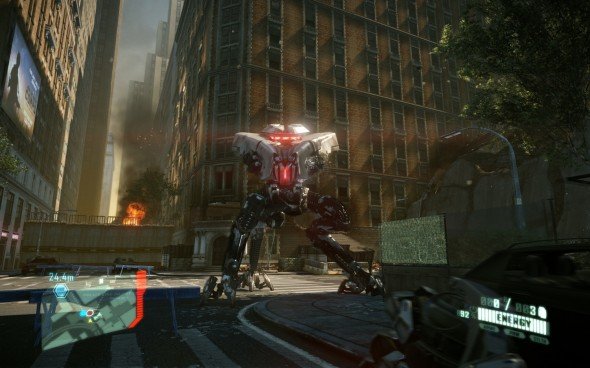
Less impressive is the way these antagonists are awkwardly woven into Crysis 2's story. As the game opens, New York City has already been decimated by a Ceph bio-weapon virus. Any citizens that didn't evacuate became gory hosts to the crippling disease, and the first few levels are spent sprinting across town to retrieve a scientist working to combat the outbreak. Then the focus immediately shifts and the virus is almost completely forgotten.
The Ceph are ravaging NYC with snaking obelisks that release spores while CELL is clashing with US Marines and trying to capture or kill you—the only hope for humanity. Why they'd want to do that is never made clear.
It's distracting that your focus as a hero is split between several interchangeable threats—the virus, the Ceph, CELL, evacuating New York or the Nanosuit's mysterious creator who chimes in later on. It also undermines the sense of commando empowerment your suit supplies when your orders come from four different characters over the course of the game.
We'll do it live
Of course, playing Crysis 2 for its story would be like buying fireworks to read the warning label. The heart of the game is its setpieces—a series of open, mini-ecosystems that stage combat with carefully placed enemy patrols, ammo caches, backdoors, and urban debris to fight around.
When you enter one, it's usually from above—through a windowsill or over a rooftop. I love how giving you this vantage creates dozens of moments where you're meant to cloak up, survey your options, and hash out a plan of action which usually goes wonderfully awry. My favorite is a midtown dock occupied by CELL. I entered through a windowsill ledge overlooking a series of small warehouses that extend into the water, connected by plank bridges lined with fuel barrels that tempt like ripe fruit. I died three times here as I experimented with unsuccessful, terrifically fun techniques: the “Reverse Depth Charge,” where I swam deep underwater with enemy-illuminating Nanovision active, then surfaced to lob a grenade or C4; stealthy rooftop sniping; and a reckless dash for a mounted turret—I hopped on and mowed down three soldiers, then ripped the gun off its bipod, leapt off the rooftop, and bagged four more kills before my Nanosuit couldn't deflect any more bullets.
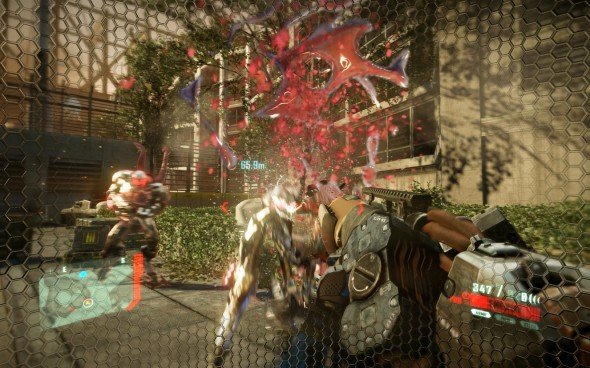
By comparison, some of the urban streets and close-quarters combat areas that act as the connective tissue between these scenes are underwhelming. New York promotes much less of the exploration, emergence and casual application of inhuman power that the tropical island did in the original Crysis. Having just replayed that game, it's so disappointing that Crysis 2 isn't a game where I can pick up a chicken and punch it a quarter mile down the block, or take a joyride on a boat on a whim. Natural jungles and their urban counterparts are obviously fundamentally different, but the inclusion of a number of linear, narrow sections—sewers, parking structures, office buildings, elevators, and two linear turret-firing vehicle battles—inhibits the freedom the Nanosuit's superhuman mobility provides. Expressing your abilities as a player demands vertical and horizontal space, and there's less of it in NYC than I would've liked.
Crysis 2's devastated Big Apple does benefit from CryEngine 3's gorgeous lighting, textures and particle effects. The specific glint and angle of sun on bricks and pavement between Central Park shrubs captures what you'd expect to see in Tribeca or along River Drive. Explosions are splashy; Ceph soldiers pop and bloom almost pornographically with boneless entrails when killed. Crysis 2 might not maintain its predecessor's open design, but it does live up to its reputation as the highest-fidelity gaming experience anywhere—and this time without necessarily bringing your PC to its knees. On a Core i7 and GTX 580, I averaged 45 FPS at a massive 2560x1600 resolution at maximum settings throughout the campaign. Playing multiplayer at maximum settings on a laptop equipped with a Core i7-720QM 1.6 GHz and running an ATI Radeon HD5870 averaged 30 FPS.
Second skin
Back to that thing you're using throughout the entire game—the Nanosuit. Using your skin feels easier than it did in Crysis. You activate armor and stealth modes on the Q and E keys, and basically see-saw between those keys through the eight-to-nine-hour campaign. This is mostly sensible; the only thing lost in this revision is that tense two seconds in Crysis' clunky radial menu every time I wanted to swap modes.
While it mirrors the capabilities of the first game's suit, this set of nanotech-pajamas actually feels less advanced. Sprint is noticeably slower than it was before, enough to diminish the sense of being genuinely superhuman. Likewise, super jump feels less like an expression of pure power—not because I couldn't leap like a human grasshopper, but because the levels are obviously designed to be traversed by a character who can reach an exact value on the Y-axis. This careful calibration makes every jump feel the same, and takes away the feeling of power you get from navigating a world built for a normal man in a god-like way.
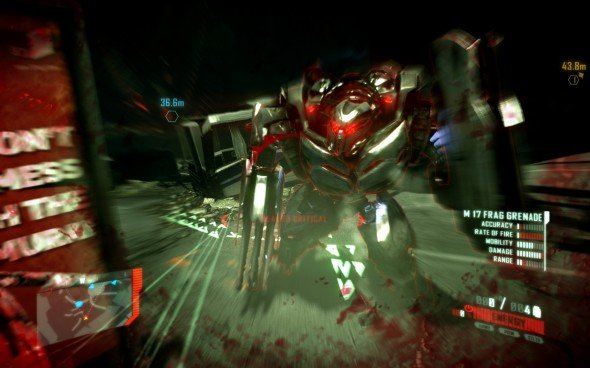
Worse is the omission of a dedicated strength mode and of fists as a selectable weapon. There's a melee bash attack, but it's not the same as leveling an enemy with a super-powered fist. It's subtle stuff—and some of it may be necessary to balance the game—but it sums to a feeling that simplifying the Nanosuit, while promoting accessibility, eliminates some of the ridiculous, emergent, purposefully overpowered stuff I did in Crysis.
I do like that Crysis 2 lets me unlock and customize the Nanosuit through the campaign by harvesting a resource from killed Ceph. A few of the unlockable modules feel too modest (one high-level skill simply slows your energy consumption while cloaked) or useless, like the Air Stomp—a hard-to-use, downward ground-pound that drains your battery and disorients you, leaving you in big trouble if you miss. It makes sense, though, to have this layer of customizability to improve and personalize the suit by investing in modules that are specialized toward speed, stealth or armor, especially since you retain that progress over multiple playthroughs.
Maximum multiplayer
I've left Crysis 2's most pleasant surprise for last: its unambitious-but-excellent multiplayer. It borrows Call of Duty's template of unlockable weapons and profile progression (play to earn more guns, attachments and perk-like Nanosuit modules) but retains its own identity by giving every player a super-suit in most modes. On paper, migrating what you do in single-player into an online arena seems like forced design. In practice, giving every player a Nanosuit cloak encourages brutal mind games, trickery, surprise and creative play, even in the context of standard multiplayer modes.
The online play owes a lot to the finely-balanced subtlety of the cloak. Unlike the Spy in Team Fortress 2, cloaking with the Nanosuit doesn't make you disappear completely. Stealthed players distort enough light around them to be noticeable if you're looking closely, but your eye usually won't find them if you're focused on another target or moving with a lot of intent.
That balance creates this absolutely satisfying internal tug-of-war between feeling strong and invulnerable or fragile and uncertain. I caught myself blasting an explosive barrel because something in my mind—an extra footstep through my headset, a shadow (which cloaked players still cast)—told me that someone was nearby. Netting a kill from that decision feels supremely lucky; finding nothing
stokes paranoia and ratchets up the tension.
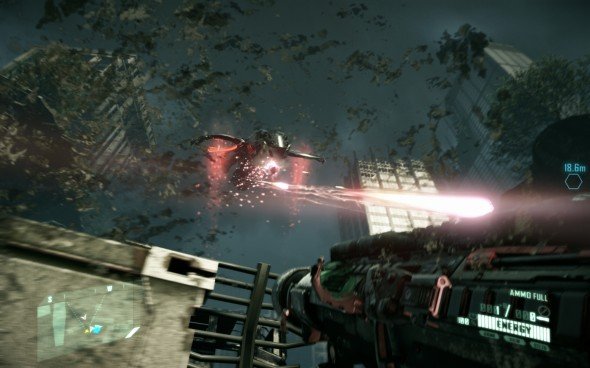
What's best is how brisk and centered on gunfighting the overall pace of MP feels. Unlike Call of Duty, there's little interference from the rewards earned by players that make consecutive kills—over a dozen matches, I was struck down by a Ceph gunship or orbital laser strike a mere two or three times. Considering the basic multiplayer template is borrowed from CoD, I'm glad Crysis shows this restraint—with the Nanosuit powers already in play, it'd be overwhelming if missile turrets, radar jamming, exploding drone vehicles, sentry turrets and other phone-in deaths were meddling with matches every other minute. Though it's unclear to what extent Crysis 2 will accommodate modding online and offline, there are some smart server modifiers that may be toggled: admins can disable premade groups from joining, give players only a single life to work with or eliminate the Nanosuit powers altogether.
Empire State
This game may look and play best on PC, but the cross-platform development has definitely had an impact. Specifically, it's disappointing to see that Crysis 2 makes some absolutely baffling technical omissions. The graphics settings menu offers just four areas to adjust: resolution, v-sync, HUD bobbing, and one of three pre-defined quality settings. Why can't I pick what level of anti-aliasing or shadow quality I want in PC gaming's most beautiful game? Quick-saving, too, is replaced by checkpoint autosaves; a developer console was also nowhere to be found.
Having finished the game (I have to mention the conclusion to the campaign, which left me more sour that BioShock's infamously anticlimactic final battle), I feel like its sins had at most a modest impact on the raw, athletic fun I had dismantling the Ceph in a gorgeous urban setting. I've got piles of complaints, sure. But I still got to spend eight hours—and many more satisfying moments in multiplayer—killing aliens and mercenaries with the most high-resolution, entertaining gunplay since FEAR in the skin of gaming's most empowering avatar. The thrill and spontaneity of outfoxing enemies with invisibility, snapping a machinegun turret off its stand and wading into danger, or sprint-leaping through the Big Apple in heavy armor is something you can't get anywhere else on the PC.
Visually near-perfect, but the ample action is bottlenecked by narrower level design and a weaker Nanosuit.

Evan's a hardcore FPS enthusiast who joined PC Gamer in 2008. After an era spent publishing reviews, news, and cover features, he now oversees editorial operations for PC Gamer worldwide, including setting policy, training, and editing stories written by the wider team. His most-played FPSes are CS:GO, Team Fortress 2, Team Fortress Classic, Rainbow Six Siege, and Arma 2. His first multiplayer FPS was Quake 2, played on serial LAN in his uncle's basement, the ideal conditions for instilling a lifelong fondness for fragging. Evan also leads production of the PC Gaming Show, the annual E3 showcase event dedicated to PC gaming.
